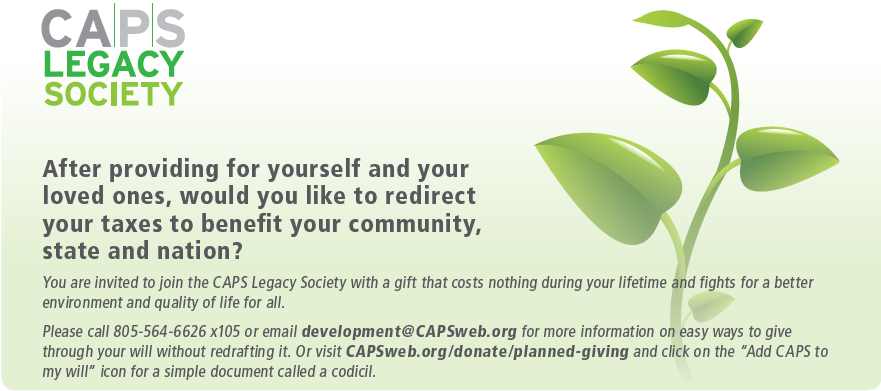Spring 2016 Newsletter
Published on June 14th, 2016
CAPS Campaigns Hit Hard on Two Hot-Button Issues
CAPS aired a new national TV commercial during CNN’s first Democratic Presidential debate to help Americans understand what presidential candidates mean when they say “anchor babies.”
Auditor Reprimands UC
For years, California’s high school students and their parents have been critical of the University of California’s preference for out of- state students
Students Win Big
Four high school students have been named winners in the CAPS “Growing Pains” video competition, conducted in partnership with the SoCal Student Film Festival to create overpopulation awareness and offer solutions.
US Population in 2065
Last fall, the Pew Research Center published its report about the current U.S. foreign-born population and its projection for U.S. population in 2065.
Guest Commentary
Carrying capacity is a concept from the science of ecology that refers to the population size of an organism, including humans, which can be supported by a particular environment.
CAPS Annual Report Summary
Legislative Update
Legislative activity in the Capitol has been relatively subdued in recent months
Michael Rivera Joins CAPS Board of Directors
CAPS welcomes Advisory Board member Michael Rivera as a new member of its board of directors.
Get Social
Have you felt it? Pro-mass-immigration, open-border activists are shaking. Supporters of the pro-America, immigration-reduction movement are speaking out more now than ever before, with much of the credit going to social media.
CAPS CAMPAIGNS HIT HARD ON TWO HOT-BUTTON ISSUES

Sanctuary city policies in California and across the country have led to tens of thousands of preventable crimes against American citizens, including murder. More attention finally was brought to the sanctuary practices of hundreds of cities when Kate Steinle was killed in San Francisco in 2015. The five-times deported, seven-times convicted illegal alien felon who committed the murder that drew nationwide outrage said he returned to one of America’s most iconic cities because he knew he would be shielded from deportation because it was a sanctuary city.
CAPS added our voice to the outcry when we called for an end to sanctuary cities that provide cover for illegal aliens. The continuing campaign includes a compelling 90-second compilation video of some of the most shocking statistics about sanctuary cities. It also features stunning comments, including from former San Francisco Sheriff Ross Mirkarimi who soon after the murder of Steinle boldly stated that being a sanctuary city made San Francisco safer, not more dangerous.
As part of the campaign, we asked the public to help us tell elected officials to end sanctuary cities. With the help of your contributions we sent blindfolds to elected officials in more than 200 sanctuary cities in 25 states and Washington, D.C. The blindfold represented their turning a “blind eye” to the havoc created by sanctuary cities. And after news broke that in 2015 Immigration and Customs Enforcement (ICE) had released nearly 20,000 illegal aliens with serious criminal convictions, including homicide, kidnapping and sexual assault, we expanded the campaign to numerous ICE field offices.
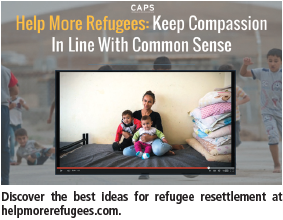 The campaign has reached more than half a million people through Facebook, Twitter and YouTube, as well as direct mail. CAPS also is running a campaign related to the Middle East migrant crisis. Ignoring strong objections from millions of Americans – including governors of 31 states – the Obama administration continues to advocate resettling more refugees in America. CAPS is pushing back with its Misguided Compassion media campaign which launched in March and engaged more than 100,000 people in the first two months after launch.
The campaign has reached more than half a million people through Facebook, Twitter and YouTube, as well as direct mail. CAPS also is running a campaign related to the Middle East migrant crisis. Ignoring strong objections from millions of Americans – including governors of 31 states – the Obama administration continues to advocate resettling more refugees in America. CAPS is pushing back with its Misguided Compassion media campaign which launched in March and engaged more than 100,000 people in the first two months after launch.
Supporters are encouraged to contact President Obama and tell him to keep compassion in line with common sense. Helping refugees in stable areas of the Middle East, instead of bringing a select few to the United States, means more people can be helped – resettling a Middle Eastern refugee in the U.S. costs 12 times more for a five-year period than sheltering that person closer to home.
The campaign also emphasizes that resettling refugees closer to home allows them to be in a better position to return home and rebuild their societies when it is safe to do so. As well, meeting the crisis at the source allows Americans to help, while also addressing legitimate safety and security concerns about admitting thousands of refugees to the U.S. who cannot be properly vetted.
AUDITOR REPRIMANDS UC
For years, California’s high school students and their parents have been critical of the University of California’s preference for out of- state students. Parents rightly complain that their taxpayer dollars fund the state’s universities, yet nonresidents who haven’t invested a dime into the state are often treated with favoritism.
The explanation for out-of-state enrollees’ preferred status is simple: nonresident tuition is sharply higher, as much as $25,000 or more per year, depending on if a student lives on or off campus and other factors.
“Nonresident” is an all-encompassing term that includes international students, highly sought by major universities because they add diversity to campuses, a goal administrators seek. The State Department’s F student visa enables soaring international admissions, now about one million annually. Since the F visa has no numerical limit, more overseas students will come unless Congress imposes a cap that allows a limited international presence in our colleges, but that doesn’t shut out deserving U.S. kids.
Email [email protected] to tell the UC Board of Regents what you think.
STUDENTS WIN BIG
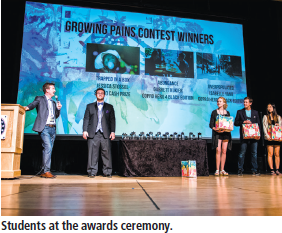 Four high school students have been named winners in the CAPS “Growing Pains” video competition, conducted in partnership with the SoCal Student Film Festival to create overpopulation awareness and offer solutions.
Four high school students have been named winners in the CAPS “Growing Pains” video competition, conducted in partnership with the SoCal Student Film Festival to create overpopulation awareness and offer solutions.
Students were encouraged to produce a video that helped viewers understand the challenges of overpopulation – from pressure on wildlife, water resources and the environment to overcrowding and worsening traffic.
Zach Letson took first place and a $3,000 prize for “Breaking Point.” His artistic video short follows the growth of an unlucky water balloon.
As the pressure continues to build, the narrator notes that growth is good, until it’s not…. Jessica Stossel’s “Trapped in a Box” won second place and $1,500 by creatively illustrating crowding using a cardboard box (representing a finite system) and colorful plastic balls (symbolizing people). Third and fourth place prizes of GoPros went to Garrett Kukier for “Abundance” and Isabelle Yang for “Overpopulated.”
 |
 |
US POPULATION IN 2065
Last fall, the Pew Research Center published its report about the current U.S. foreign-born population and its projection for U.S. population in 2065.
Pew found that foreign-born levels in the U.S. today stand at a record 59 million immigrants which represents 14 percent of the nation’s total population, up from 5 percent since the 1965 Immigration and Nationality Act.
During that 50-year period, immigrants, their children and grandchildren have accounted for 55 percent of all U.S. population growth.The 1965 legislation had a much greater effect on population growth than many anticipated.
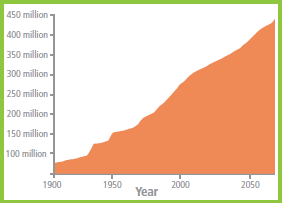 The 59 million immigrants who came to the U.S. between 1965 and 2015, mostly from Mexico, Latin American and Asia, exceed those who arrived in European-dominated immigration waves during the 19th and early 20th centuries. Between 1840 and 1889, 14.3 million immigrants came to the U.S., and between 1890 and 1919, an additional 18.2 million arrived.
The 59 million immigrants who came to the U.S. between 1965 and 2015, mostly from Mexico, Latin American and Asia, exceed those who arrived in European-dominated immigration waves during the 19th and early 20th centuries. Between 1840 and 1889, 14.3 million immigrants came to the U.S., and between 1890 and 1919, an additional 18.2 million arrived.
Pew forecasts that by 2065, assuming current immigration patterns remain the same, 103 million additional immigrants and their descendants will account for 88 percent of all population growth and will push U.S. population to an unthinkable 441 million people. The U.S. has the world’s highest immigrant population; 20 percent of all global immigrants live in the U.S.
California is and will continue to be the state most dramatically affected by federal immigration legislation that fuels population growth. More than one in four of today’s foreign-born, approximately 10 million people, live in California. And based on Department of Homeland Security statistics, an estimated 2.8 million illegal aliens reside in California, compared to 1.5 million in 1990.
GUEST COMMENTARY
 CLEVERNESS, HUMAN INVENTIONS DON’T TRUMP CARRYING CAPACITY
CLEVERNESS, HUMAN INVENTIONS DON’T TRUMP CARRYING CAPACITY
Carrying capacity is a concept from the science of ecology that refers to the population size of an organism, including humans, which can be supported by a particular environment.
Often applied to animal manage-ment, carrying capacity depends on the nature, quality and productivity of a habitat or environment. The more productive the habitat– the higher its food and energy output – the higher the animal populations it can support. Conversely, low-productivity habitats have lower carrying capacities.
Grasslands, rainforests, coral reefs, wetlands and forests are productive habitats in terms of “standing biomass” and plant matter produced by photosynthesis. Thus, they can support sizable animal populations that feed on plants and each other in a cyclical food chain.
In contrast, deserts, Arctic tundra, alpine zones and Antarctica all are low-quality, low-productivity habitats, and can support only low animal population densities and biomass, or none at all.
Many utopian thinkers enamored of human exceptionalism argue that carrying capacity limits are invalid for humans because our intelligence and inventiveness allow us to continually circumvent and overcome natural resource limits.
There is some truth to this. For example, we run out of wood for cooking and heating, but discover how to exploit denser energy sources – coal and oil. These fossil fuels begin to run short, and we develop nuclear and solar energy. Our tremendous human population growth wouldn’t have occurred if not for Man’s many innovations and technical advances.
But here’s the rub: technology has limitations; it’s not magic. It is the ignorant and the ideologues who persist in proclaiming that Man is Transcendent. Economists, politicians, science fiction fans and others place much faith in the infinite ability of the free market, input substitution and the fertile human mind to avert limits or hurdles nature might place in the path of perpetual progress for humanity.
Back in the real world, populations can and do temporarily exceed carrying capacity, but then they are in a precarious condition of “overshoot.” During overshoot, habitat is damaged and resources used unsustainably. Ecological economists call this short-lived phase “depletion of natural capital.” Following overshoot, populations might collapse, die out or, if lucky, fall back to a more sustainable level.
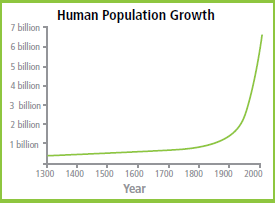 At present, on both national and global scales, human population is well advanced along the overshoot trajectory – an unsustainable, untenable situation.
At present, on both national and global scales, human population is well advanced along the overshoot trajectory – an unsustainable, untenable situation.
What can we do to face the reality of carrying capacity – to “live within limits,” as ecologist Garrett Hardin once put it? Through public and private sector policy, and individual action, we can reduce resource consumption and waste by conserving energy and using resources more efficiently – use less; live smarter. We can also shift to more renewable energy sources, a transition already begun.
Another essential part of any approach to environmental sustainability and living within carrying capacity is halting population growth. We must stabilize our population, and over time reduce it gradually and humanely to a more sustainable level. Tall orders, but doable.
Sooner or later, our population will stop growing, but how this happens is still very much up in the air. Whether it happens because birth rates drop to sustainable levels, or because death rates rise, makes all the difference.
Leon Kolankiewicz
CAPS Advisory Board Member,
Senior Writing Fellow
ANNUAL REPORT 2015 SUMMARY
CAPS MISSION STATEMENT
CAPS works to formulate and advance policies and programs designed to stabilize the population of California, the U.S. and the world at levels which will preserve the environment and a good quality of life for all.
This is an overview of calendar year 2015 activities and results from CAPS. To request the full annual report, with financial statements and media coverage summary, call 805-564-6626 or email [email protected].
Overpopulation-related problems in California and the United States continue to be the focus of the educational and media work of CAPS. With multi-year drought in the Southwest, CAPS had a very real example of the demands from growth intersecting with natural resources and climate change, and talked about this in our outreach efforts.
In 2015, we continued to work to inform the public, elected officials and the media about the destructive results of unchecked population growth driven primarily by high levels of legal and illegal immigration. We discussed economic and job-related issues, compromised environment, loss of biodiversity, stressed educational and medical systems, heightened security concerns and overall diminished quality of life.
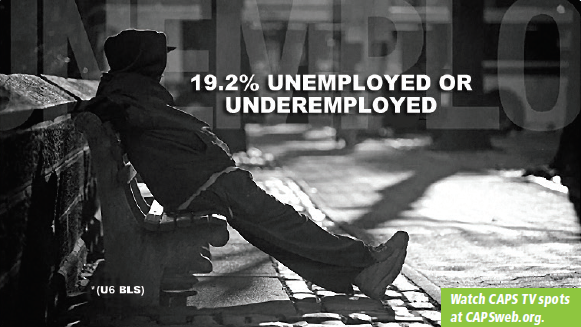 CAPS reaffirmed its belief that the U.S. needs a population policy that limits overall immigrant numbers, discourages illegal immigration and supports family planning. Within admission limits, we support consideration for admitting immigrants with needed skills, rather than having country-by-country basis quotas or a random lottery.
CAPS reaffirmed its belief that the U.S. needs a population policy that limits overall immigrant numbers, discourages illegal immigration and supports family planning. Within admission limits, we support consideration for admitting immigrants with needed skills, rather than having country-by-country basis quotas or a random lottery.
Throughout the year, our messaging reinforced these ideas. In January we launched a TV spot, “Was an Endless Flow of Immigrant Workers who Take Jobs and Suppress Wages Dr. King’s Dream?” that questioned President Obama’s executive action rewarding four million illegal aliens with amnesty and work permits when millions of African Americans, Hispanic Americans and others continue to struggle with high unemployment, underemployment and wage stagnation.
In April, sparked by California’s historic drought, CAPS ran our TV ad linking California’s declining environment to immigration-driven population growth. In media interviews and outreach, we made the point that nearly 100 percent of California’s growth during a ten-year period came from immigration and births to immigrants. Our primary solution to reversing California’s environmental decline is to slow mass immigration, so we can slow population growth and save some California for future generations.
In October, CAPS launched a campaign to help Americans better understand the term “anchor baby” and the impact of giving citizenship to children born to those in the country illegally. CAPS was the only national organization to run a TV ad on this issue, a hotly debated topic among presidential candidates. Listeners were directed to USAnchorBabies.org.
CAPS proved once again we are not afraid to tackle difficult subjects and tread where others might not.
 Outreach to California State Legislature and Congress
Outreach to California State Legislature and Congress
CAPS engaged in advocacy programs to influence elected leadership in California and at the federal level. Our Action Alert Team members were busy in 2015 phoning, emailing and faxing elected officials.
Our members urged their representatives to support the Birthright Citizenship Act of 2015 to restore the original intent of the 14th Amendment, support the Legal Workforce Act for mandatory E-Verify and increase interior enforcement of federal immigration laws. And thousands of messages were sent to both houses of Congress protesting the ill-advised Fast Track Authority and Trans-Pacific Partnership which would displace American workers.
The murder of Kate Steinle by a recently released illegal alien with a long criminal record drew national attention to the issue of sanctuary cities and to ICE detention practices. CAPS supported a number of state and national measures to rein in sanctuary jurisdictions.
The California We Are Losing – Views of Our Golden State from Pristine to Imperiled
CAPS continued sharing our video of individual remembrances that chronicles how California has changed in the last 100 years.
Watch it at CAPSweb.org/about/california-then-now
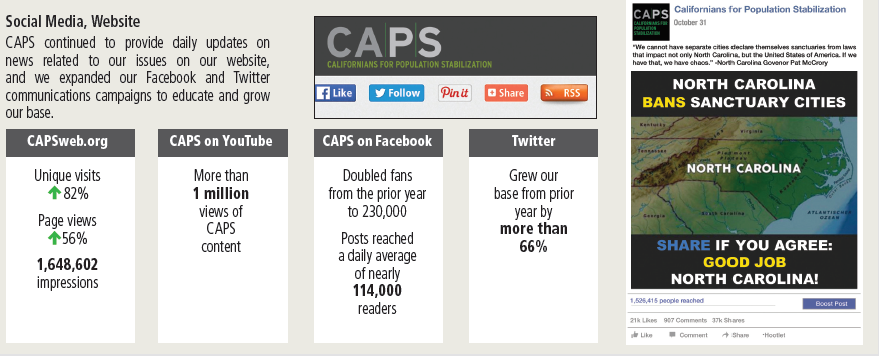
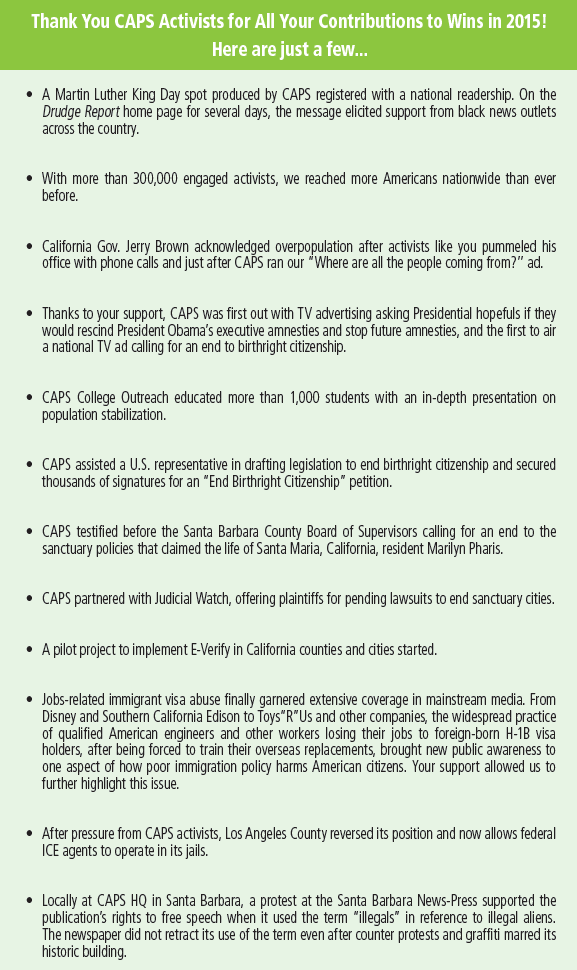 CAPS Senior Writing Fellows Program
CAPS Senior Writing Fellows Program
Our fellows and contributing writers were published and interviewed throughout the year by multiple news outlets, and they contributed original commentary to the CAPS blog which is updated throughout the week.
As well, CAPS Fellow and Advisory Board Member Leon Kolankiewicz penned long-form pieces addressing California’s epic drought and Earth’s limits to growth.
Open Dialogue/College Outreach Program
CAPS hit the lecture circuit on college campuses with respected conservationists who understand the immigration-overpopulation-environmental connection, including Dave Foreman, founder of the Rewilding Institute, and Philip Cafaro, author of How Many is Too Many?
CROWDIFORNIA Student Video Contest
For the CAPS Crowdifornia Video Contest, high school and college students submitted videos showing how overpopulation impacts California.
Ally Cizowski of Brentwood, Tennessee, won first place and $5,000 for her video which addressed crowded California roads, driver’s licenses for illegal aliens and public transportation.
See the winning entries at CAPSweb.org/crowdifornia-video-contest.
 New Voices on the CAPS Boards In 2015
New Voices on the CAPS Boards In 2015
CAPS welcomed Kristin Larson to the CAPS Board of Directors and Dario Sattui to the Advisory Board. Kristin’s international law practice focuses on environmental business law, and her interest in population issues stems from concerns for moderating environmental impacts and sustaining healthy ecosystems.
A fourth generation San Franciscan whose great-grandfather was one of California’s first winemakers, Sattui is a long-time businessman who refounded the family winery, V. Sattui Winery, in Napa Valley. Dario has worked on environmental causes and population stabilization since college.
Population Education for Scientists, Environmentalists Across the Country
CAPS provided informational materials to Scientists and Environmentalists for Population Stabilization for conferences and Earth Day events throughout the U.S. and supported the participation of several visiting scientists for the events.
LEGISLATIVE UPDATE
WASHINGTON
Legislative activity in the Capitol has been relatively subdued in recent months, even as the immigration debate, and the public attention to it, has loomed large in the campaign for the White House. While the election debate about immigration has largely been about illegal immigration and refugee admissions, it has at times turned to broader issues, such as E-Verify, the impact of legal immigration on American workers and the abuse of “temporary” work visas.
HR 1147, the Legal Workforce Act, would mandate the E-Verify system for businesses, employment agencies and union halls. It passed the House Judiciary Committee but has not received a floor vote. HR 4598/S 2394 would crack down on the abuse of H-1B visas by limiting them to those with significant educational achievement or postdegree experience, returning the program to its intended purpose of bringing in a few select specialists. CAPS supports these important bills.
The migrant flow from the Middle East and North Africa into Europe and the U.S., and its links to terrorism, put a spotlight on refugee admissions. HR 4038, the SAFE Act, would have barred the admission of any refugee from Syria or Iraq unless the DHS, FBI and Director of National Intelligence certify that the individual does not present a security threat to this country. The bill passed the House with an almost veto-proof vote of 289-137, with 47 Democrats joining 242 Republicans in support, but it was blocked in the Senate.
Amnesty lawsuit in Supreme Court
In April, the Supreme Court heard the legal challenge brought by 26 states to President Obama’s latest immigration amnesty. The Fifth Circuit Court of Appeals denied the administration’s appeal to overturn the temporary injunction against the November expansion of the DACA amnesty. There are a number of technical legal issues, so the ruling may not address the merits of the case. Should the court split 4-4, the lower ruling would stand, albeit with no national precedent.
SACRAMENTO
The California legislature continues its campaign to obscure the distinction between legal immigrants and those who come or remain here illegally. SB 1139 would fund scholarship and loan forgiveness programs for students who are in our country illegally if they are studying in a medical field. SB 10 would require California to apply to the federal government for a waiver to allow those in the country illegally to purchase health insurance under California’s health insurance exchange that was created under Obamacare. SB 1139 is set for a hearing, and SB10 is on the Governor’s desk, where we are pressuring for a veto. CAPS opposes efforts in Sacramento to put taxpayers on the hook for the financial costs of illegal immigration.
MICHAEL RIVERA JOINS CAPS BOARD OF DIRECTORS

CAPS welcomes Advisory Board member Michael Rivera as a new member of its board of directors. Rivera has a long-time commitment to addressing the impacts of illegal immigration and has advocated the use of E-Verify by local municipalities and governments.
Rivera has served on numerous boards and commissions in Central California, including the Santa Maria Recreation and Parks (commissioner and chairman of the board), County of Santa Barbara Private Industry Council (commissioner, chairman and CFO), City of Guadalupe (planning commissioner) and various committees, including the Mayors Housing Task Force.
![]() Have you felt it? Pro-mass-immigration, open-border activists are shaking. Supporters of the pro-America, immigration-reduction movement are speaking out more now than ever before, with much of the credit going to social media.
Have you felt it? Pro-mass-immigration, open-border activists are shaking. Supporters of the pro-America, immigration-reduction movement are speaking out more now than ever before, with much of the credit going to social media.
Mediums such as Facebook and Twitter give concerned citizens the tools to express their opinions and spread news fast and easily. And CAPS’ social media sites are growing and continue to gain momentum.
Our Facebook page currently has more than 310,000 followers, and is growing by thousands every week, and our Twitter page recently reached 8,000 followers! We regularly post news items, infographics and link to our blog.
CAPS can be found on Facebook, Twitter, Instagram and Pinterest. If you haven’t joined us on social media, check us out! It’s a great way to watch the movement grow, engage with like-minded supporters and help make a difference.
